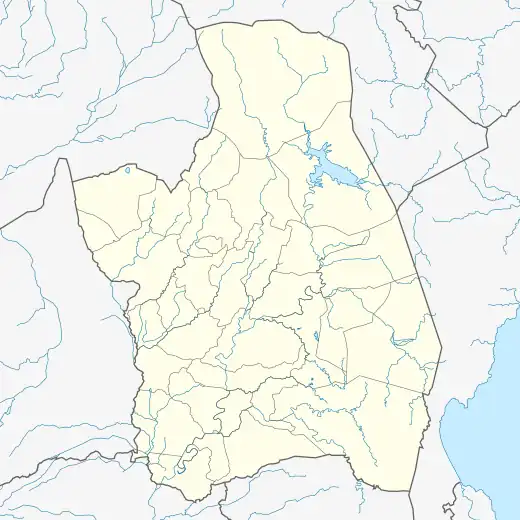| Cabanatuan Cathedral | |
|---|---|
.jpg.webp) The newly renovated cathedral in 2023 | |
 Cabanatuan Cathedral Location in Nueva Ecija .svg.png.webp) Cabanatuan Cathedral Location in Luzon .svg.png.webp) Cabanatuan Cathedral Location in the Philippines | |
| 15°29′21″N 120°57′51″E / 15.4892°N 120.9643°E | |
| Location | Cabanatuan, Nueva Ecija |
| Country | Philippines |
| Denomination | Roman Catholic |
| Website |
|
| History | |
| Status | Cathedral |
| Founded | 1700 |
| Dedication | Saint Nicholas of Tolentino |
| Architecture | |
| Functional status | Active |
| Architectural type | Church building |
| Style | Neoclassical (2019) |
| Completed | 1866, 1891, 1975 |
| Demolished | 1880, 1934, 1972 |
| Administration | |
| Archdiocese | Lingayen-Dagupan |
| Diocese | Cabanatuan |
| Clergy | |
| Bishop(s) | Sofronio Aguirre Bancud |
| Vicar(s) |
|
| Priest(s) | Rev.Fr. Reynold H. Oliveros, J.C.D |
Cabanatuan Cathedral (Filipino: Katedral ng Cabanatuan), officially known as the Saint Nicholas of Tolentino Parish Cathedral (Filipino: Parokyang Katedral ni San Nikolas ng Tolentino), is the ecclesiastical seat of the Roman Catholic Diocese of Cabanatuan in the Philippines. It is located at Del Pilar Street, Barangay General Luna, in downtown Cabanatuan, Nueva Ecija province.[1]
The cathedral and the Plaza Lucero at its front, is nationally and historically known as the death place of Filipino general Antonio Luna.[2][3]
History
After the parishes of Gapan in 1595 and Santor in 1636, the Augustinian priests founded the Cabanatuan church in 1700 as a visita of Gapan. By 1732, it only had 700 parishioners. The parish administration was transferred to secular priests in 1866, and in the same year, the first stone church and convent buildings were constructed under the leadership of Jose de la Fuente. The said buildings were destroyed by the earthquake of July 18, 1880 and were reconstructed under the helm of Mariano Rivas in 1891.[4]
During the Philippine–American War, the cathedral's convent, shortly served as the seat of the capital of the Philippines[5] where Antonio Luna and his aide-de-camp, Francisco Román, were killed by the members of the Kawit Battalion on June 5, 1899.[1][6] In 1934, the church was razed by fire wherein only its lateral walls were spared. Nine years after the canonical foundation of the Diocese of Cabanatuan, the cathedral, and its adjacent former College of the Immaculate Conception building, was charred again on September 28, 1972. Three years later, on November 22, 1975, the church reconstruction was finished under Pacifico Araullo. It was dedicated by then Cabanatuan Bishop Vicente Reyes and then Apostolic Nuncio to the Philippines, Bruno Torpigliani.[4]
A new cathedral, locally called as crypta, is being constructed since 1999 in Sumacab Este, Cabanatuan that can accommodate 3,000 people.[7]
Gallery
_03.jpg.webp) Close-up of the cathedral's facade
Close-up of the cathedral's facade The bishop's cathedra
The bishop's cathedra Stained glass at the cathedral facade featuring Nicholas of Tolentino
Stained glass at the cathedral facade featuring Nicholas of Tolentino Stained glass depicting the Holy Spirit on the ceiling above the altar
Stained glass depicting the Holy Spirit on the ceiling above the altar Cathedral sanctuary in 2015
Cathedral sanctuary in 2015 The nave of the cathedral in 2015
The nave of the cathedral in 2015 Image of the Santo Niño of Cabanatuan
Image of the Santo Niño of Cabanatuan Cathedral sanctuary in 2012
Cathedral sanctuary in 2012 Cathedral patio
Cathedral patio Parish office
Parish office_08.jpg.webp) A statue at the cathedral
A statue at the cathedral Cathedral at night
Cathedral at night
References
- 1 2 "In Nueva Ecija, Antonio Luna remembered sans fanfare". Philippine Daily Inquirer. Retrieved June 26, 2021.
- ↑ "Where to go in Cabanatuan when you hardly know the place". Inquirer Lifestyle. Retrieved June 26, 2021.
- ↑ "Cabanatuan City". League of Cities of the Philippines. Retrieved June 26, 2021.
- 1 2 "St. Nicholas Of Tolentine Parish Cathedral / Historic Cabanatuan Cathedral". Facebook. Diocese of Cabanatuan. Retrieved January 30, 2021.
- ↑ "The First Philippine Republic". National Historical Commission of the Philippines. Archived from the original on October 7, 2021. Retrieved June 26, 2021.
- ↑ Jose, Vivencio (1991). The Rise and Fall of Antonio Luna (reprint ed.). Solar Publishing Corporation. p. 377. ISBN 9711707004.
- ↑ "History of the Diocese of Cabanatuan". Diocese of Cabanatuan. Retrieved June 26, 2021.
External links
 Media related to Saint Nicholas of Tolentino Cathedral (Cabanatuan City) at Wikimedia Commons
Media related to Saint Nicholas of Tolentino Cathedral (Cabanatuan City) at Wikimedia Commons- Diocesan website Archived 2021-02-03 at the Wayback Machine
- Facebook page